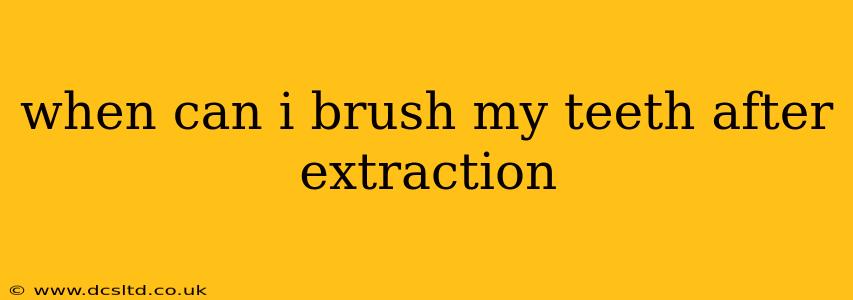Tooth extraction, while a common procedure, leaves your mouth vulnerable. Knowing when and how to brush your teeth afterward is crucial for preventing infection and promoting proper healing. This guide answers all your questions about brushing after an extraction, drawing on dental expertise and best practices.
How Soon Can I Brush My Teeth After a Tooth Extraction?
The general recommendation is to wait at least 24 hours before brushing near the extraction site. This allows the blood clot to form, which is essential for preventing a dry socket—a painful complication. However, you can brush the rest of your teeth gently as normal after this initial waiting period. Think of it like this: you're giving the area time to heal before introducing the potential irritation of a toothbrush.
What About the Extraction Site Itself?
After the initial 24-hour period, you can cautiously begin brushing around the extraction site, but with extreme gentleness. Use a soft-bristled toothbrush and avoid directly scrubbing the area. Instead, focus on brushing the surrounding teeth to maintain oral hygiene without disturbing the healing process.
Can I Use Mouthwash After a Tooth Extraction?
Using mouthwash after a tooth extraction is a topic with some nuances. Avoid using alcohol-based mouthwashes, as these can irritate the healing wound. If your dentist recommends a specific mouthwash, follow their instructions carefully. Saltwater rinses are generally safe and can help promote healing by gently cleansing the area. However, avoid vigorous rinsing or swishing; instead, gently swish the saltwater around your mouth and spit it out.
What if I Develop a Dry Socket?
A dry socket occurs when the blood clot at the extraction site dislodges. This exposes the bone and nerve endings, leading to significant pain. Signs of a dry socket include:
- Severe, persistent pain starting 2-3 days after extraction.
- A bad taste or odor in your mouth.
- Visible bone in the socket.
If you suspect a dry socket, contact your dentist immediately. They can provide treatment to relieve the pain and help the area heal properly.
How Long Should I Wait Before Brushing Normally Again?
The time it takes to return to your normal brushing routine depends on the complexity of the extraction and individual healing times. Generally, after a week or two, you should be able to brush normally around the extraction site, as long as the healing process is progressing well. If you have concerns, check with your dentist for personalized advice.
What Kind of Toothbrush Should I Use After Extraction?
As mentioned earlier, a soft-bristled toothbrush is crucial after an extraction. Hard bristles can disrupt the healing process and irritate the sensitive area. Consider switching to a very soft-bristled brush during the healing phase.
Are There Special Techniques for Brushing After Extraction?
The key is gentleness. Focus on brushing the teeth adjacent to the extraction site with delicate, circular motions. Avoid aggressive scrubbing, pressure, or direct contact with the healing area.
When Can I Floss After a Tooth Extraction?
Similar to brushing, you should wait at least 24 hours before flossing near the extraction site. When you do resume flossing, be extremely gentle and avoid disturbing the healing clot. You may need to temporarily adjust your flossing technique to bypass the extraction area until it heals completely.
This information is for general guidance only and should not be considered a substitute for professional dental advice. Always consult your dentist or oral surgeon for personalized post-extraction care instructions. They can provide the best recommendations tailored to your specific situation.
